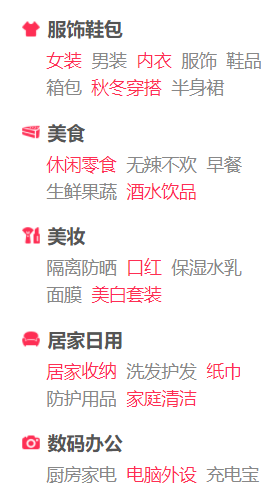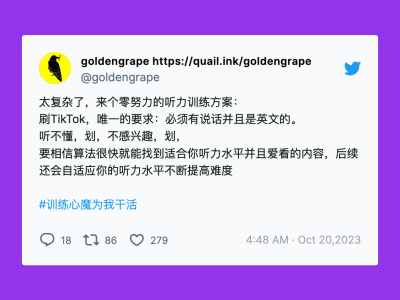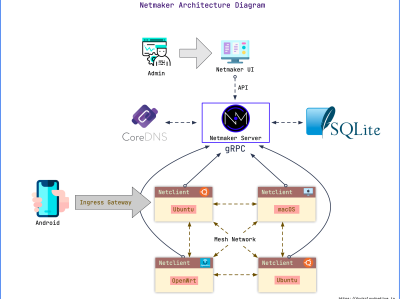sing-box 是什么#
sing-box 是新一代超强通用代理工具,对标 *ray core 与 clash,而且它的性能以及支持的协议类型已经超过了 *ray core 与 clash。目前支持以下协议:
入站:
Shadowsocks(including shadowsocks2022)
Vmess
Trojan
Naive
Hysteria
ShadowTLS
Vless
Tuic
Tun
Redirect
TProxy
Socks
HTTP
出站:
Shadowsocks(including shadowsocks2022)
Vmess
Trojan
Wireguard
Hysteria
ShadowTLS
ShadowsocksR
VLESS
Tuic
Hysteria2
Tor
SSH
DNS
除了命令行客户端以外,还提供了图形界面客户端,图形界面支持 Android、iOS、macOS 以及 Apple tvOS,Windows 暂时不支持,还在施工中 ?
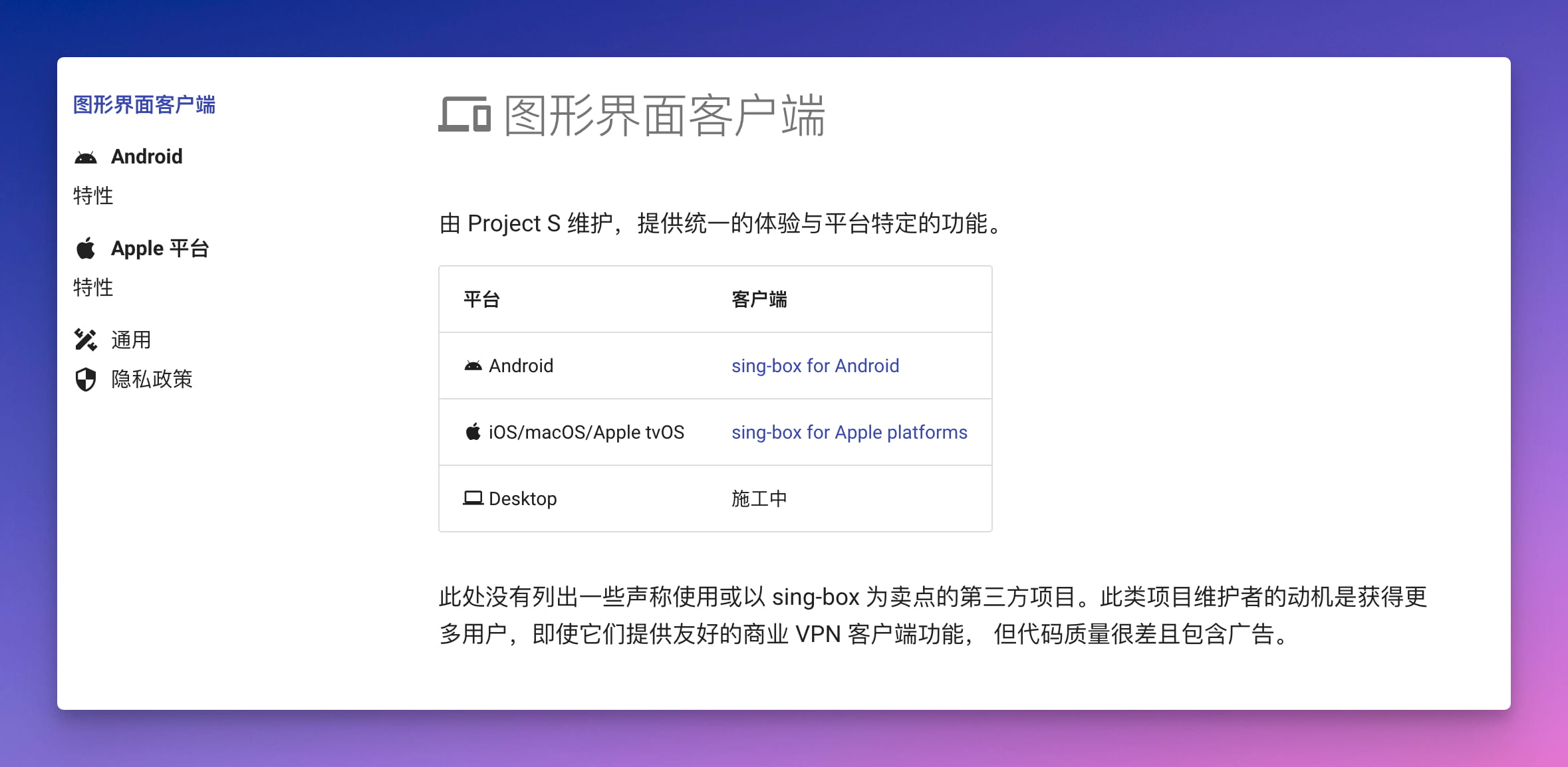
这简直就是魔法上网界的瑞士军刀啊!而且所有的客户端都是免费的,iOS 端也不用再买 Shadowrocket 小火箭等付费 App 了。再看看隔壁 Surge 的价格:
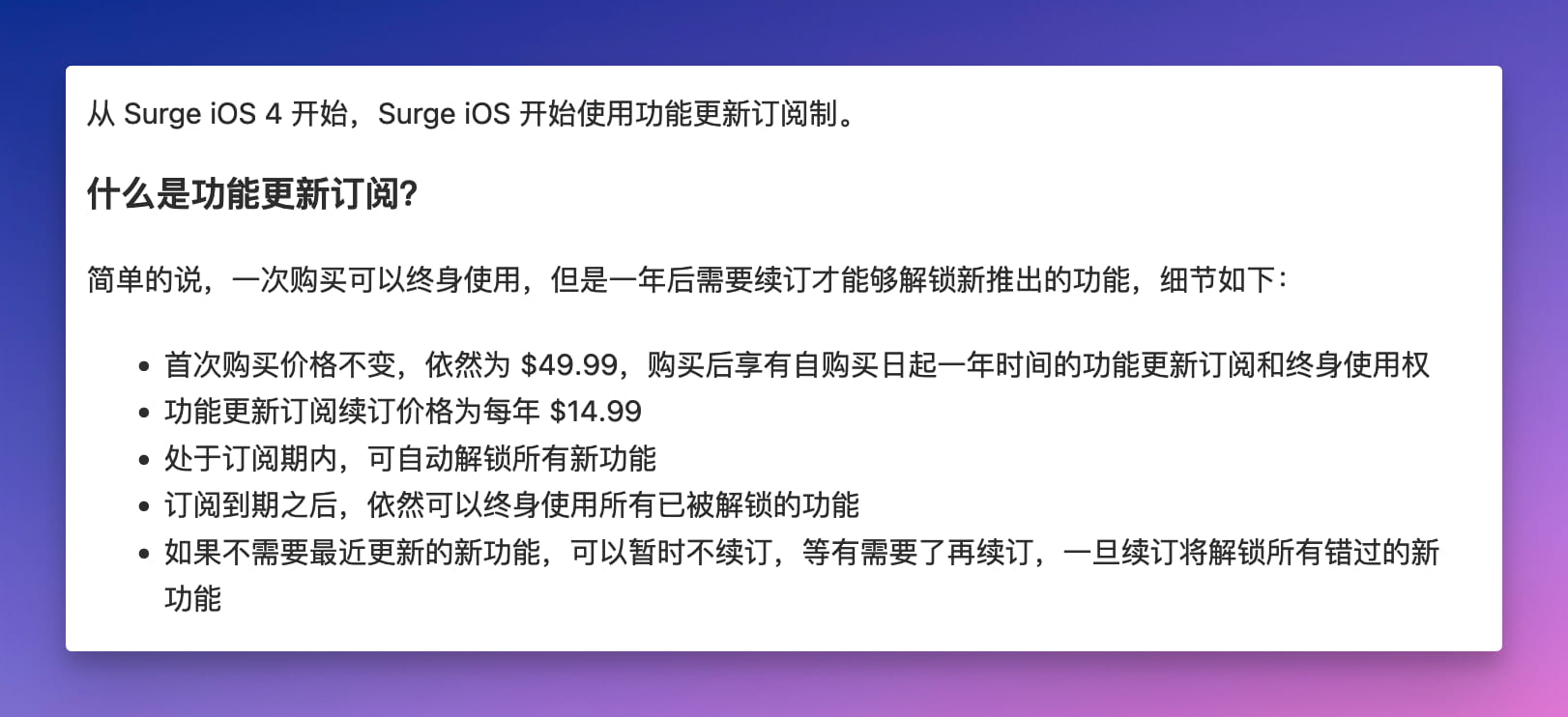
你玩我呢??
还是 sing-box 香。本文将会手把手教大家如何使用 sing-box 来实现任意机器的全局透明代理。
sing-box 客户端下载#
第一步先解决客户端下载的问题。
Android#
Android 客户端可以到 Play Store 中去下载:
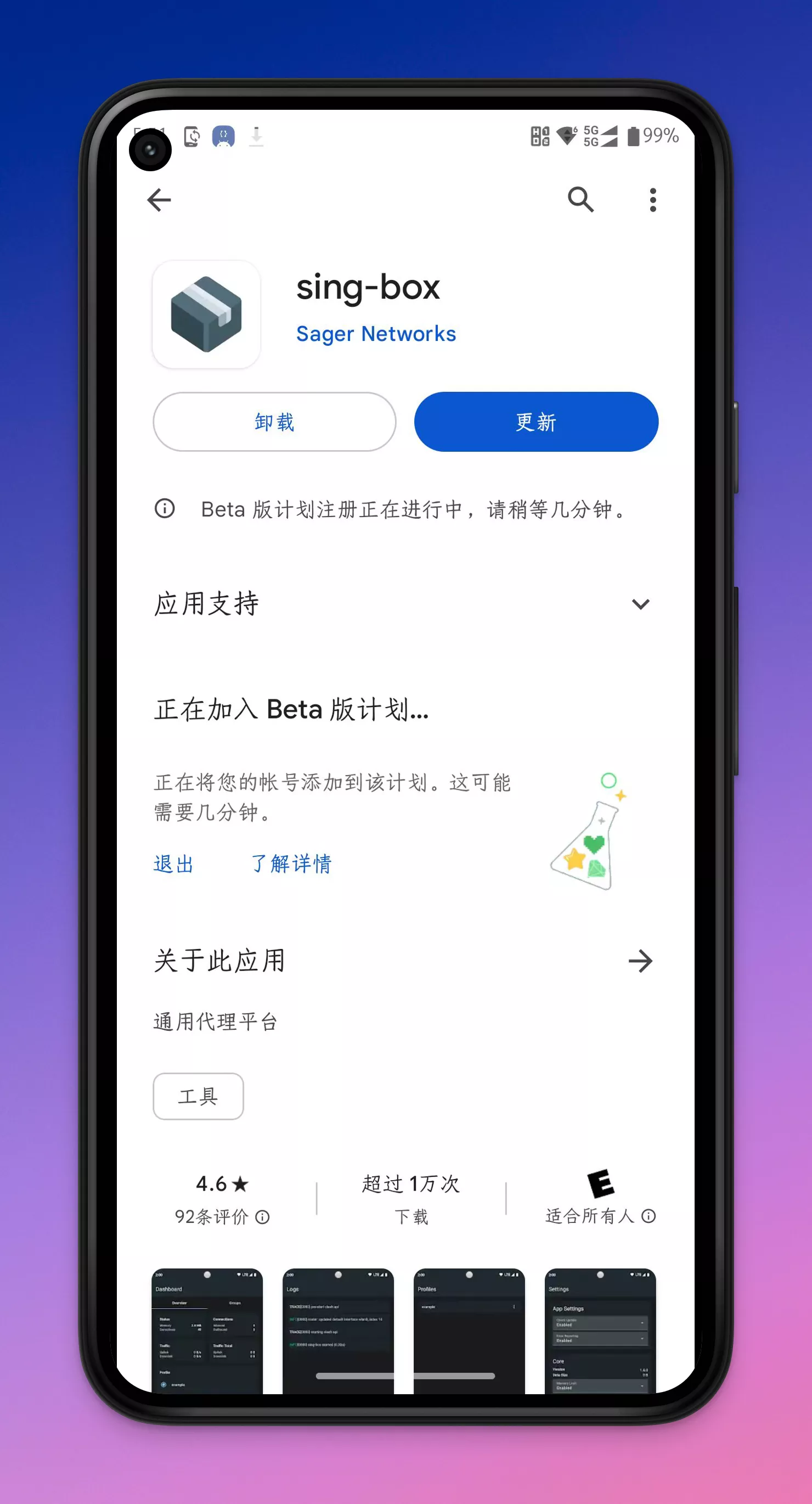
也可以直接到 GitHub Releases 页面下载。
如果你是 Android 的 Magisk/KernelSU 玩家,可以选择刷入 box_for_magisk 模块。
Apple 平台#
iOS/macOS/Apple tvOS 用户可以到 App Store 中下载(前提是你得有个美区 ID),也可以使用 Homebrew 直接安装:
$ brew install sfm
除此之外你也可以直接到 GitHub Releases 页面下载客户端或者命令行版本。
Windows#
Windows 没有图形界面客户端,官方还正在开发中,不过可以直接使用包管理器 Sccop 或者 Chocolatey 安装命令行版本:
# Sccop $ scoop install sing-box # Chocolatey $ choco install sing-box
你也可以选择第三方开发者开发的图形界面客户端: GUI.for.SingBox
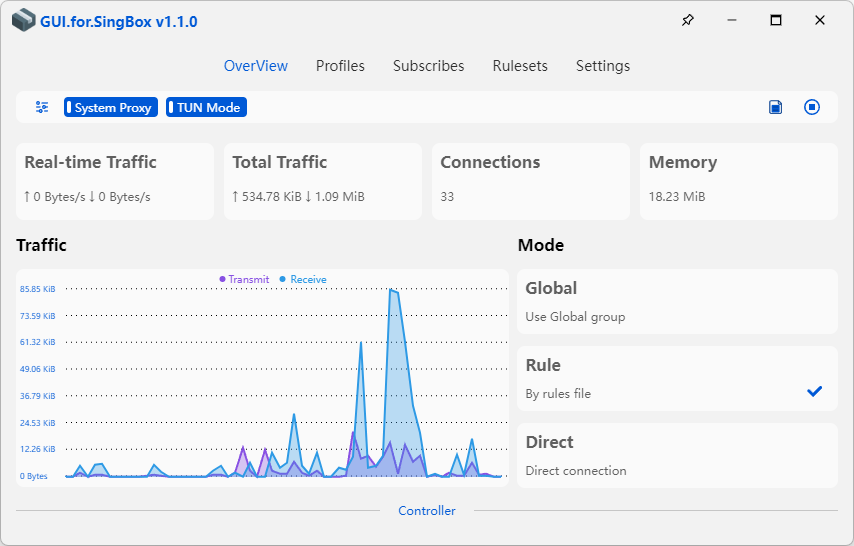
还有一个更加成熟的第三方客户端: Hiddify-Next
Linux#
Linux 就很简单了,直接到 GitHub Releases 页面下载命令行版本即可。
sing-box 配置解析#
sing-box 的核心就是它的配置,所有的配置都在一个 JSON 文件里,每个配置参数的含义可参考 sing-box 官方文档。
但是为了能够快速使用起来,我们需要一个示例模板。没问题,我这就给你一个比较完美的透明代理模板:
sing-box 透明代理示例模板
下面我来给大家解析一下里面的配置,首先来看 DNS 部分。
如果你嫌下面的解析太长不看,那就直接使用我的示例模板配置好了。
DNS 配置#
sing-box 对 DNS 的处理比 Clash 强太多了,支持各种分流规则,结构如下:
{ "dns": { "servers": [], "rules": [], "final": "", "strategy": "", "disable_cache": false, "disable_expire": false, "independent_cache": false, "reverse_mapping": false, "fakeip": {} } }其中 servers 定义了 DNS 服务器,具体参数含义我就不解释了,自己看官方文档。我给出的 DNS 服务器配置是:
{ "dns": { "servers": [ { "tag": "dns_proxy", "address": "https://1.1.1.1/dns-query", "address_resolver": "dns_resolver", "strategy": "ipv4_only", "detour": "select" }, { "tag": "dns_direct", "address": "h3://dns.alidns.com/dns-query", "address_resolver": "dns_resolver", "strategy": "ipv4_only", "detour": "direct" }, { "tag": "dns_block", "address": "rcode://refused" }, { "tag": "dns_resolver", "address": "223.5.5.5", "strategy": "ipv4_only", "detour": "direct" } ] } }这里定义了 3 个 DNS 服务器,当你发起一个域名解析请求时,这些服务器会被用来查找对应的 IP 地址。同时还定义了一个 RCode 协议用来屏蔽请求。
rules 定义了 DNS 规则,这些规则用于定义哪些域名应该使用哪个 DNS 服务器解析。它可以让你根据域名的特定模式选择不同的 DNS 服务器。DNS 规则如下:
{ "dns": { "rules": [ { "outbound": "any", "server": "dns_resolver" // 注释:对于任何出站连接(不管是直接连接还是通过代理),使用 "dns_resolver" 服务器进行 DNS 解析(这一句主要用来解析代理节点本身的 IP 地址)。 }, { "clash_mode": "direct", "server": "dns_direct" // 注释:在直连模式(不经过代理)下,使用 "dns_direct" 服务器进行 DNS 解析。 }, { "clash_mode": "global", "server": "dns_proxy" // 注释:在全局代理模式下,使用 "dns_proxy" 服务器进行 DNS 解析。 }, { "process_name": [ "TencentMeeting", "NemoDesktop", "ToDesk", "ToDesk_Service", "WeChat", "Tailscale", "wireguard-go", "Tunnelblick", "softwareupdated", "kubectl" ], "server": "dns_direct" // 注释:当特定的进程(如 TencentMeeting、WeChat 等)发起 DNS 请求时,使用 "dns_direct" 服务器进行直连 DNS 解析。 }, { "domain_suffix": [ "icloudnative.io", "fuckcloudnative.io", "sealos.io", "cdn.jsdelivr.net" ], "server": "dns_direct" // 注释:对于特定后缀的域名(如 icloudnative.io 等),使用 "dns_direct" 服务器进行直连 DNS 解析。 }, { "process_name": ["DropboxMacUpdate", "Dropbox"], "server": "dns_proxy" // 注释:当 Dropbox 相关进程发起 DNS 请求时,使用 "dns_proxy" 服务器通过代理进行 DNS 解析。 }, { "package_name": [ "com.google.android.youtube", "com.android.vending", "org.telegram.messenger", "org.telegram.plus" ], "server": "dns_proxy" // 注释:对于特定的 Android 应用包名(如 YouTube、Telegram 等),使用 "dns_proxy" 服务器通过代理进行 DNS 解析。 }, { "rule_set": "geosite-geolocation-!cn", "server": "dns_proxy" // 注释:对于 geosite 数据库中定义的非中国地区的地理位置相关的域名,使用 "dns_proxy" 服务器通过代理进行 DNS 解析。 }, { "rule_set": "Global", "server": "dns_proxy" // 注释:对于定义在 "Global" 规则集中的域名,使用 "dns_proxy" 服务器通过代理进行 DNS 解析。 }, { "rule_set": [ "YouTube", "Telegram", "Netflix", "geoip-google", "geoip-telegram", "geoip-twitter", "geoip-netflix" ], "server": "dns_proxy" // 注释:对于特定的服务和地理位置相关的域名(如 YouTube、Netflix、谷歌、Telegram 相关的域名),使用 "dns_proxy" 服务器通过代理进行 DNS 解析。 } ], "final": "dns_direct" // 注释:如果上述规则都不适用,则默认使用 "dns_direct" 服务器进行直连 DNS 解析。 } }入站配置#
接下来比较重要的就是入站规则了,入站(Inbound)在网络领域,特别是在代理和网络路由配置中,通常指的是进入某个系统或网络的数据流。在 sing-box 中,入站配置定义了如何处理进入代理服务器的数据。入站配置示例如下:
{ "inbounds": [ { "type": "tun", "inet4_address": "198.18.0.1/16", "auto_route": true, "exclude_package": [ "cmb.pb", "cn.gov.pbc.dcep", "com.MobileTicket", "com.adguard.android", "com.ainemo.dragoon", "com.alibaba.android.rimet", "com.alicloud.databox", "com.amazing.cloudisk.tv", "com.autonavi.minimap", "com.bilibili.app.in", "com.bishua666.luxxx1", "com.cainiao.wireless", "com.chebada", "com.chinamworld.main", "com.cmbchina.ccd.pluto.cmbActivity", "com.coolapk.market", "com.ctrip.ct", "com.dianping.v1", "com.douban.frodo", "com.eg.android.AlipayGphone", "com.farplace.qingzhuo", "com.hanweb.android.zhejiang.activity", "com.leoao.fitness", "com.lucinhu.bili_you", "com.mikrotik.android.tikapp", "com.moji.mjweather", "com.motorola.cn.calendar", "com.motorola.cn.lrhealth", "com.netease.cloudmusic", "com.sankuai.meituan", "com.sina.weibo", "com.smartisan.notes", "com.sohu.inputmethod.sogou.moto", "com.sonelli.juicessh", "com.ss.android.article.news", "com.ss.android.lark", "com.ss.android.ugc.aweme", "com.tailscale.ipn", "com.taobao.idlefish", "com.taobao.taobao", "com.tencent.mm", "com.tencent.mp", "com.tencent.soter.soterserver", "com.tencent.wemeet.app", "com.tencent.weread", "com.tencent.wework", "com.ttxapps.wifiadb", "com.unionpay", "com.unnoo.quan", "com.wireguard.android", "com.xingin.xhs", "com.xunmeng.pinduoduo", "com.zui.zhealthy", "ctrip.android.view", "io.kubenav.kubenav", "org.geekbang.geekTime", "tv.danmaku.bili" ], "stack": "mixed", "sniff": true }, { "type": "socks", "tag": "socks-in", "listen": "::", "listen_port": 5353 } ] }下面是对每个字段的详细注释:
第一个入站连接的配置:
type:"tun"表示这是一个 tun 虚拟网络接口的配置。inet4_address:"198.18.0.1/16"设定了虚拟网络接口的 IPv4 地址和子网掩码。auto_route:true表示将自动处理路由,确保数据包正确传输。exclude_package: 这是一个数组,包含了不通过此虚拟网络接口处理的 Android 应用程序包名列表。列出的 Android 应用程序将使用常规网络接口而不是虚拟接口。stack:"mixed"表示混合systemTCP 栈与gvisorUDP 栈。sniff:true表示启用流量嗅探功能,以便自动检测和处理传入的数据流类型。
第二个入站连接的配置:
type:"socks"表示这是一个 SOCKS 代理配置。tag:"socks-in"为这个入站连接定义了一个标签,方便在其它配置中引用。listen:"::"表示监听所有 IPv6 地址。如果需要监听所有 IPv4 地址,可以使用"0.0.0.0"。listen_port:5353定义了 SOCKS 代理监听的端口号。
其中 tun 接口是核心部分,我们将利用 tun 接口来实现全局透明代理。
出站配置#
出站(Outbound)是指从本地网络或设备发出,向外部网络、服务或互联网发送的数据流量。示例出站配置如下:
{ "outbounds": [ { "type": "selector", // 类型为选择器,用于在多个出站中选择一个 "tag": "select", // 标签名为 "select" "outbounds": [ "trojan-out" // 可选择的出站列表,这里只有 "trojan-out" ], "default": "trojan-out" // 默认选择的出站为 "trojan-out" }, { "type": "selector", // 同样是选择器类型 "tag": "openai", // 标签名为 "openai" "outbounds": [ "trojan-out" // 可选择的出站仍然是 "trojan-out" ], "default": "trojan-out" // 默认选择的出站同样是 "trojan-out" }, { "type": "selector", // 选择器类型 "tag": "tiktok", // 标签名为 "tiktok" "outbounds": [ "trojan-out" // 可选择的出站是 "trojan-out" ], "default": "trojan-out" // 默认选择的出站为 "trojan-out" }, { "type": "trojan", // 类型为 Trojan "tag": "trojan-out", // 标签名为 "trojan-out" "server": "xxxxxxxx", // Trojan 服务器地址 "server_port": 9443, // Trojan 服务器端口 "password": "xxxxxxxx", // Trojan 连接密码 "tls": { "enabled": true, // 启用 TLS 加密 "server_name": "xxxxxxxx", // TLS 服务器名称 "insecure": true, // 不验证 TLS 证书,用于自签名证书 "utls": { "fingerprint": "chrome" // 使用 Chrome 的 TLS 指纹 } }, "multiplex": { "protocol": "h2mux", // 使用 h2mux 多路复用协议 "max_connections": 4, // 最大连接数为 4 "min_streams": 4 // 每个连接的最小流数为 4 }, "transport": { "type": "grpc", // 传输协议为 gRPC "service_name": "TunService" // gRPC 服务名称 } }, { "type": "direct", // 直连类型,不通过代理直接访问 "tag": "direct" // 标签名为 "direct" }, { "type": "block", // 阻止类型,用于拦截流量 "tag": "block" // 标签名为 "block" }, { "type": "dns", // DNS 类型,用于 DNS 查询 "tag": "dns-out" // 标签名为 "dns-out" } ] }这个配置定义了不同类型的出站连接方式,包括选择器、Trojan、直连、阻止和 DNS 类型。每种类型都通过标签进行标识,便于在后续的路由规则中引用。
路由配置#
路由部分才是 sing-box 的核心配置,这个部分定义了一系列规则和参数,用于决定如何处理不同的网络请求。通过这些规则和参数,sing-box 可以非常灵活地处理复杂的路由需求,包括基于地理位置、IP 地址、端口号、域名等多种条件的流量分流。配置结构如下:
{ "route": { "rules": [], "rule_set": [], "final": "direct", // "final" 字段定义了默认的路由行为。这里设置为 "direct",意味着如果没有匹配任何规则,流量将直接(不经代理)发送。 "auto_detect_interface": true // 表示自动检测网络接口。这有助于自动适应网络变化,确保路由正确。 } }其中的核心配置:
路由规则 (
rules): 这些规则定义了如何根据不同的条件将流量定向到不同的出站连接。每个规则可以包括多个条件,如域名、IP 地址、端口号、网络协议等。规则集 (
rule_set): 从 sing-box 1.8.0 版本开始,规则可以组合成规则集,这使得配置更加灵活和模块化。
路由规则#
以下是我给出的路由规则示例:
{ "route": { "rules": [ { "protocol": "dns", // 使用DNS协议的流量 "outbound": "dns-out" // 将通过'dns-out'出口转发 }, { "clash_mode": "direct", // Clash模式为直连 "outbound": "direct" // 将通过'direct'出口直接连接 }, { "clash_mode": "global", // Clash模式为全局 "outbound": "select" // 将通过'select'出口选择转发 }, { "domain_suffix": [ // 特定后缀的域名 "icloudnative.io", "fuckcloudnative.io", "sealos.io", "cdn.jsdelivr.net" ], "outbound": "direct" // 将通过'direct'出口直接连接 }, { "process_name": [ // 特定进程名称 "TencentMeeting", "NemoDesktop", ... ], "outbound": "direct" // 将通过'direct'出口直接连接 }, { "rule_set": [ // 特定的规则集 "WeChat", "Bilibili" ], "outbound": "direct" // 将通过'direct'出口直接连接 }, { "protocol": "quic", // 使用QUIC协议的流量 "outbound": "block" // 将被阻止 }, { "inbound": "socks-in", // 来自'socks-in'入口的流量 "outbound": "select" // 将通过'select'出口选择转发 }, { "rule_set": "OpenAI", // OpenAI规则集 "outbound": "openai" // 将通过'openai'出口转发 }, { "domain_suffix": [ // OpenAI相关的域名后缀 "openai.com", "oaistatic.com", "oaiusercontent.com" ], "outbound": "openai" // 将通过'openai'出口转发 }, { "package_name": "com.openai.chatgpt", // OpenAI ChatGPT应用包名 "outbound": "openai" // 将通过'openai'出口转发 }, { "rule_set": "TikTok", // TikTok规则集 "outbound": "tiktok" // 将通过'tiktok'出口转发 }, { "package_name": "com.zhiliaoapp.musically", // TikTok应用包名 "outbound": "tiktok" // 将通过'tiktok'出口转发 }, { "domain_suffix": [ // 特定的域名后缀 "depay.one", "orbstack.dev" ], "outbound": "select" // 将通过'select'出口选择转发 }, { "process_name": [ // 特定的进程名称 "DropboxMacUpdate", "Dropbox" ], "outbound": "select" // 将通过'select'出口选择转发 }, { "package_name": [ // 特定应用包名 "com.google.android.youtube", ... ], "outbound": "select" // 将通过'select'出口选择转发 }, { "domain": "accounts.google.com", // 特定的域名 "domain_suffix": [ // 特定的域名后缀 "sourceforge.net", "fhjasokiwq.com" ], "outbound": "select" // 将通过'select'出口选择转发 }, { "domain_suffix": "cloud.sealos.io", // 特定的域名后缀 "outbound": "direct" // 将通过'direct'出口直接连接 }, { "type": "logical", // 逻辑类型规则 "mode": "and", // 使用'and'模式 "rules": [ // 组合规则 { "rule_set": "geosite-geolocation-!cn" }, { "rule_set": "geoip-cn", "invert": true } ], "outbound": "select" // 将通过'select'出口选择转发 }, { "rule_set": "Global", // Global规则集 "outbound": "select" // 将通过'select'出口选择转发 }, { "rule_set": "geoip-cn", // 中国地理位置IP规则集 "outbound": "direct" // 将通过'direct'出口直接连接 }, { "ip_is_private": true, // 私有IP地址 "outbound": "direct" // 将通过'direct'出口直接连接 }, { "rule_set": [ // 特定的规则集 "YouTube", "Telegram", "Netflix", "geoip-google", "geoip-telegram", "geoip-twitter", "geoip-netflix" ], "outbound": "select" // 将通过'select'出口选择转发 } ] } }这个配置定义了不同类型的流量(如基于协议、域名后缀、应用包名、进程名称等)如何被路由。每条规则都指定了一种流量类型和相应的“出口”,即流量应该如何被处理或转发。这种灵活的路由配置可以非常精确地控制网络流量。
规则集#
以下是我给出的规则集示例:
{ "route": { "rule_set": [ { "type": "remote", "tag": "geosite-geolocation-!cn", "format": "binary", "url": "https://mirror.ghproxy.com/https://raw.githubusercontent.com/SagerNet/sing-geosite/rule-set/geosite-geolocation-!cn.srs", "download_detour": "direct" }, { "type": "remote", "tag": "geoip-cn", "format": "binary", "url": "https://mirror.ghproxy.com/https://raw.githubusercontent.com/CHIZI-0618/v2ray-rules-dat/release/singbox_ip_rule_set/geoip-cn.srs", "download_detour": "direct" }, { "type": "remote", "tag": "geoip-google", "format": "binary", "url": "https://mirror.ghproxy.com/https://raw.githubusercontent.com/CHIZI-0618/v2ray-rules-dat/release/singbox_ip_rule_set/geoip-google.srs", "download_detour": "direct" }, { "type": "remote", "tag": "geoip-telegram", "format": "binary", "url": "https://mirror.ghproxy.com/https://raw.githubusercontent.com/CHIZI-0618/v2ray-rules-dat/release/singbox_ip_rule_set/geoip-telegram.srs", "download_detour": "direct" }, { "type": "remote", "tag": "geoip-twitter", "format": "binary", "url": "https://mirror.ghproxy.com/https://raw.githubusercontent.com/CHIZI-0618/v2ray-rules-dat/release/singbox_ip_rule_set/geoip-twitter.srs", "download_detour": "direct" }, { "type": "remote", "tag": "geoip-netflix", "format": "binary", "url": "https://mirror.ghproxy.com/https://raw.githubusercontent.com/CHIZI-0618/v2ray-rules-dat/release/singbox_ip_rule_set/geoip-netflix.srs", "download_detour": "direct" }, { "type": "remote", "tag": "Global", "format": "source", "url": "https://mirror.ghproxy.com/https://raw.githubusercontent.com/yangchuansheng/sing-box-geosite/main/rule/Global.json", "download_detour": "direct" }, { "type": "remote", "tag": "YouTube", "format": "source", "url": "https://mirror.ghproxy.com/https://raw.githubusercontent.com/yangchuansheng/sing-box-geosite/main/rule/YouTube.json", "download_detour": "direct" }, { "type": "remote", "tag": "OpenAI", "format": "source", "url": "https://mirror.ghproxy.com/https://raw.githubusercontent.com/yangchuansheng/sing-box-geosite/main/rule/OpenAI.json", "download_detour": "direct" }, { "type": "remote", "tag": "TikTok", "format": "source", "url": "https://mirror.ghproxy.com/https://raw.githubusercontent.com/yangchuansheng/sing-box-geosite/main/rule/TikTok.json", "download_detour": "direct" }, { "type": "remote", "tag": "Telegram", "format": "source", "url": "https://mirror.ghproxy.com/https://raw.githubusercontent.com/yangchuansheng/sing-box-geosite/main/rule/Telegram.json", "download_detour": "direct" }, { "type": "remote", "tag": "Netflix", "format": "source", "url": "https://mirror.ghproxy.com/https://raw.githubusercontent.com/yangchuansheng/sing-box-geosite/main/rule/Netflix.json", "download_detour": "direct" }, { "type": "remote", "tag": "WeChat", "format": "source", "url": "https://mirror.ghproxy.com/https://raw.githubusercontent.com/yangchuansheng/sing-box-geosite/main/rule/WeChat.json", "download_detour": "direct" }, { "type": "remote", "tag": "Bilibili", "format": "source", "url": "https://mirror.ghproxy.com/https://raw.githubusercontent.com/yangchuansheng/sing-box-geosite/main/rule/Bilibili.json", "download_detour": "direct" } ] } }这里有两种不同类型的规则集,一种是 binary,另外一种是 source。binary 规则集一般都是利用 GEOSITE 或者 GEOIP 直接编译好的二进制规则,它们被直接嵌入到应用程序中。而 source 规则集就和 Clash 的 ruleset 比较类似,它是一个文本文件,而不是二进制。
目前已经有相关项目可以自动将网络上的 Clash Ruleset 规则自动转换为 sing-box 的 source 规则集,感兴趣的同学可以参考这个项目: sing-box-geosite
Clash API#
最后的实验性配置用来开启 Clash API。没错,sing-box 是兼容 Clash API 滴!那么我们就可以使用 Clash 的 dashboard 来管理 sing-box 了,直接用这个项目好了: metacubexd
示例配置如下:
{ "experimental": { "cache_file": { "enabled": true // 启用缓存文件功能。当此项设置为true时,启用 DNS 查询的缓存,以便加快后续相同查询的响应速度。 }, "clash_api": { "external_controller": "0.0.0.0:9090", // 定义 Clash API 的外部控制器地址。"0.0.0.0:9090" 表示在本机的9090端口上监听外部的连接请求。 "external_ui": "metacubexd", // 指定外部用户界面(UI)的名称。这里的 "metacubexd" 是一个自定义 UI 的名称。 "external_ui_download_url": "https://github.com/MetaCubeX/metacubexd/archive/refs/heads/gh-pages.zip", // 提供外部 UI 的下载 URL。这个 URL 是从 GitHub 上下载 "metacubexd" UI 的压缩包。 "external_ui_download_detour": "select", // 定义下载外部 UI 时使用的转发策略。"select" 表示将通过'select'出口选择转发 "default_mode": "rule" // 设置 Clash API 的默认模式。"rule" 模式意味着流量将根据用户定义的规则进行路由。 } } }最终启动 sing-box 之后就可以通过 Clash dashboard 来查看和管理流量啦:
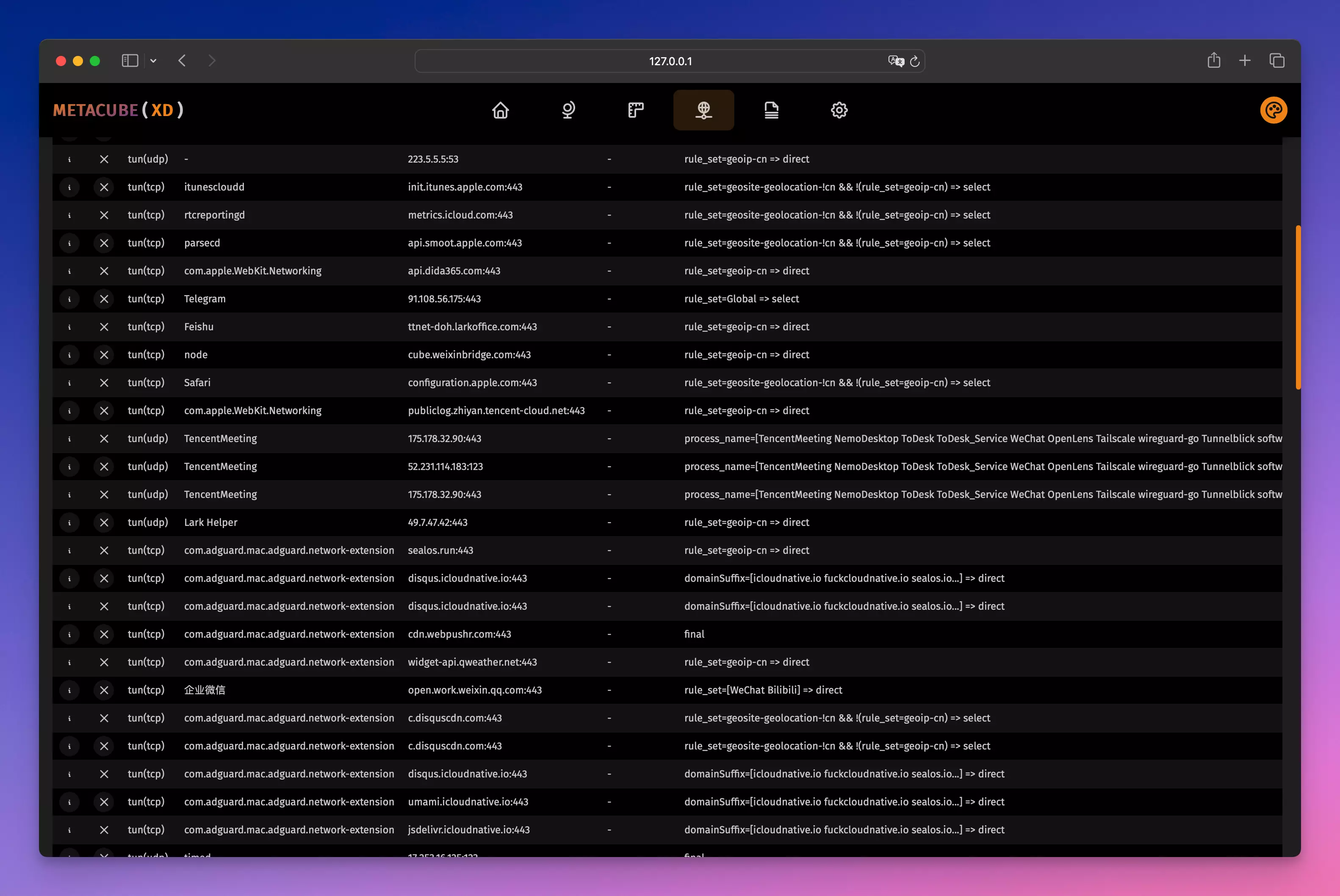
注意: 图形界面客户端会自动把外部控制器相关的配置给屏蔽掉,如果你想使用 Dashboard,只能使用命令行来启动 sing-box。
订阅转换#
我想大部分小伙伴使用的还是订阅链接,不可能傻乎乎的自己写配置和规则。但是目前大部分ji场都不提供 sing-box 的配置格式,仅有少量ji场提供支持,其他ji场可使用下面这个项目将常见订阅转换为 sing-box 订阅格式: sing-box-subscribe
你可以将这个项目部署到自己的 Vercel 中,然后使用以下的链接格式来将常见订阅转换为 sing-box 订阅格式:
<URL>/url=<subscription_url>/&file=<sing-box_template_url>
<URL>:这是你的 sing-box-subscribe 访问链接;<subscription_url>:这是你的订阅链接;<sing-box_template_url>:这是你的 sing-box 模板配置链接,你可以直接使用 我的模板。
例如:
https://sing-box-subscribe.vercel.app/config/url=https://xxxxxx?clash=1/&file=https://gist.githubusercontent.com/yangchuansheng/5182974442015feeeeb058de543a00fd/raw/45b11ff08188af021da98e7174923d719dc42dd9/gistfile1.txt
如果你有多个订阅链接,需要先将订阅链接合并为一个链接,然后再进行转换,具体看参考 sing-box-subscribe 的官方文档。
更多配置示例#
更多的配置示例可以参考这个项目: sing-box-examples
这个项目针对每一个代理协议都提供了详细的配置示例,还有很多的骚操作,比如 将 Cloudflare 的 Warp 节点信息直接提取出来加到 sing-box 出站配置中去,妙啊!
透明网关#
如果你想让局域网中的所有机器都能够根据规则智能分流,那就在局域网中找一台机器作为透明网关,在这台机器上运行一个 sing-box 就行了,不需要像 Clash 一样写什么乱七八糟的 iptables 规则,直接一个配置文件就行了,非常简单。通常我们使用软路由来完成这个任务,如果你不想使用软路由,那随便找一台机器就行了,当然最好还是使用 Linux 比较靠谱。
在网关上运行 sing-box 之后,其他机器只需要将网关指向这台机器,便可以无痛开启魔法智能分流了。
注意: 其他机器的 DNS 必须是公网 DNS,不能使用内网 DNS!你的 DNS 可以指向任意的公网 DNS,反正只要是公网就行,比如:114.114.114.114,因为 sing-box 会劫持局域网中的所有 DNS 请求。
当然,如果你不想让 sing-box 劫持局域网中的所有 DNS 请求,可以使用如下的方案:
首先在入站配置中添加一个监听端口:
{ "inbounds": [ { "type": "direct", "tag": "dns-in", "listen": "0.0.0.0", "listen_port": 53 } ] }然后在路由规则中将 DNS 的规则改成如下的配置:
{ "route": { "rules": [ { "inbound": "dns-in", "outbound": "dns-out" } ] } }这样就保证了只有从 53 端口进来的流量才会进入 DNS 解析。
重启生效后,将其他机器的网关和 DNS 均指向这台机器就可以了。
如果你使用的是 DHCP,只需要在 DHCP 服务器中将 DHCP 分配的网关和 DNS 改成 sing-box 所在的机器 IP 即可。
本文链接:https://kinber.cn/post/5020.html 转载需授权!
推荐本站淘宝优惠价购买喜欢的宝贝:

 支付宝微信扫一扫,打赏作者吧~
支付宝微信扫一扫,打赏作者吧~